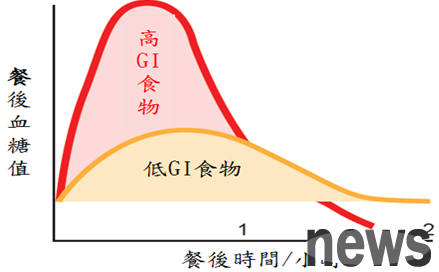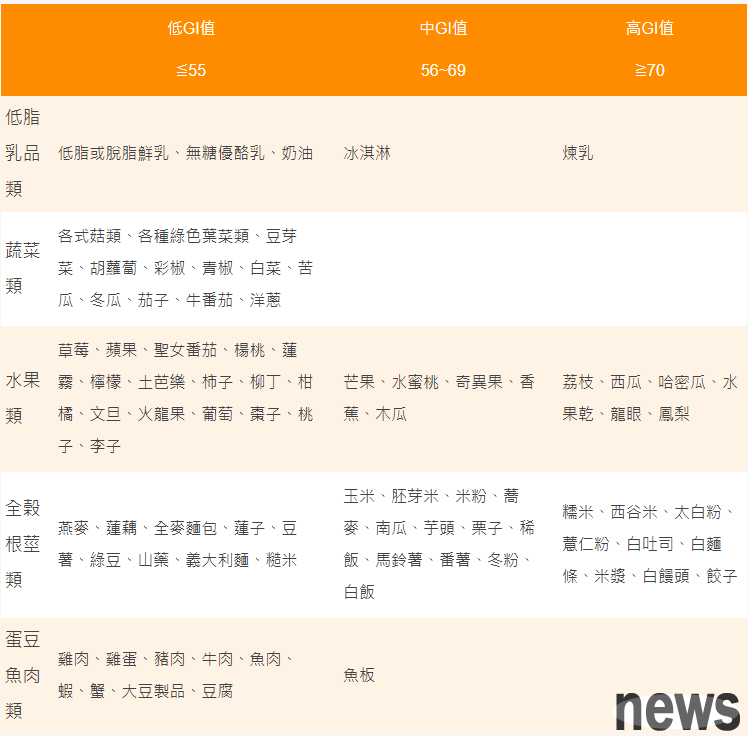Low GI diet not only adds to the feeling of foot, but also controls blood sugar! A list of GI foods and 16 types of landmine foods

Modern people are increasingly paying attention to health. In recent years, low-GI healthy meals have become quite popular, and various restaurants have also seen spring after the rain. So, what is a low GI? What are the foods for low GI? Is it helpful for weight loss and blood sugar control? The following is a detailed introduction.
What is a low GI? First understand the definition of GI value. The new clinic pointed out that the GI value (Glycemic Index) is the "glycemic index", which refers to the relative speed of blood sugar increase when food enters the human body within 2 hours. It is used to measure the impact of sugar-based foods on the increase in blood sugar. Although some foods contain less sugar, the rate of blood sugar rise is slow. The larger the GI value of a food, the easier it means that blood sugar will rise. Therefore, taking "low GI food" can prevent blood sugar from increasing rapidly, which is more beneficial to physical health.

Great Glucose changes after food intake of high and low GI. (Picture/District Administration.)
According to the teaching information of the National Health Administration, the GI value is between 1 and 100. The calculation method is based on the blood sugar increase value within 2 hours after consuming pure glucose (pure glucose) 100 grams as the basis (GI value = 100). Other foods compare the blood sugar increase value within 2 hours after consumption with the blood sugar increase value of pure glucose. This shows the speed of the sugar contents caused by the digestion and absorption of the food in the gastric tract. This is the so-called GI value, that is, Glycemic Index "Saccharin (glucose) Index".
Glycemic index (GI value) can be divided into three levels: low, medium and high, to benefit the people's diet. Reference:
. Low glycemic index: ≦55, the impact on blood sugar fluctuations is smaller
. The medium-lift glycemic index: 56~69, the impact on blood sugar fluctuations is between
. High-glycemic index: ≧70, has a greater impact on blood sugar fluctuations
What are the foods with low GI? What are the common low-GI foods and fruits that you can see at one time? The nutritional office of Pingtung Branch of the Pingtung Branch of Kaohsiung Rongmin Hospital lists low, medium and high GI common foods, including dairy products, vegetables, fruits, whole-video root locks, eggs, beans, fish and meat, etc., and the following table is detailed:

The National Health Administration pointed out that low GI diet is not only suitable for diabetics, but also very helpful for weight loss. The benefits of low GI diet are as follows:
. It has a more foot feeling and is less likely to get hungry, so you can avoid overeating.
. It can reduce blood insulin value and reduce heat production and fat formation.
. Helps reduce body fat and can maintain lean muscle tissue.
. Lower pyrosterol (LDL).
. Can improve good pyrosterol (high and low density lipoprotein pyrosterol HDL).
. It can help manage blood sugar levels and reduce the risk of cardiovascular diseases, diabetes and its complications.
What factors affect the GI value?The digestibility of the powder of the food itself: the digestion time of polysaccharide powder is long, so the GI value is lower; on the contrary, single sugars are quickly absorbed by the body, and the GI value is naturally higher. Food nutrients: For foods with protein or fat, the digestive and healing procedure is more complicated, which makes blood sugar rise slower, so the GI value will be lower.
Food type: Compared with blocked foods, thin and chopped foods are easier to absorb and have a higher GI value; taking fruits as an example, the rate at which juice increases blood sugar faster than eating fruits directly.
Database content: The higher the data, the lower the GI value. Taking the high-dimensional full-meal bread as an example, its GI value is 69, which is a medium-sized glycemic index food; while white bread is 88, which is a high-sized glycemic index food.
Cooking method: The same weight of rice and thinner food, the higher the GI value after the flour gelatinization, the thinner food is higher than that of rice. In addition, after stir-frying, the flour ages and the kidneys are slow to empty, which is relatively low-GI foods compared to rice. However, the hot amount of fried rice with oil may be 1 times higher than that of rice. Therefore, low-GI foods do not mean low-hot amounts. Pay special attention to the "cooking method" in this regard, which will also affect the amount of heat. Other foods eaten at the same time: white or white bread with high GI value can also reduce the GI value if eaten with vegetables. Therefore, clinical nutritionists always explain to patients why they need to eat vegetables.
In addition, I would like to remind you that the sugar-raising index of foods may vary depending on the source of food, variety, maturity and cooking and processing methods.
Who is suitable for a low GI diet?People who are suitable for low GI diet include:
Diabetic patients The National Health Administration pointed out that the concept of "low GI" was first used for diabetic diets. Diabetic patients often have high blood sugar after eating. In order to control their blood sugar, in addition to drugs, choosing "foods that make blood sugar rise slower" is also important for diabetic patients.
Foreign research points out that eating more high-GI foods (such as refined powdered foods, white rice, glutinous rice, white toast or white bread, etc.) will accelerate blood sugar rise, which can easily cause hunger and cause appetite, increase appetite, and promote food remuneration, produce a lot of fat, increase the accumulation of fat in human blood or cells, which will prevent weight loss..
The blood sugar concentration in "low GI food" will not rise too fast, and insulin will not be secreted in large quantities, thereby achieving the purpose of controlling blood sugar and reducing weight.
Who is not suitable for a low GI diet?Hanfang Yupin Daisy Nutritionist pointed out that because low-GI foods usually contain higher fiber and have longer digestion and absorption time, the following groups are not suitable:
. Patients with hypoglycemia. Those who have overweight
. Idioyal
. People with gastrointestinal symptoms such as gastrointestinal aura and abdominal distension will not gain weight if they eat low-GI food every day? Low GI does not equal low heat
In addition to GI value, the total heat of diet is also very important for blood sugar control, because "low GI" does not equal "low heat". Many people who have a slight understanding of low GI diet will think that as long as it is a food with low GI value, you can feel safe and you won’t get fat. In fact, this is a serious and wrong concept. A low GI diet pattern actually requires choosing food types within a certain range of total food heat, so that you can achieve the effect of reducing fat, controlling blood sugar and blood fat concentration. From a different perspective, a low GI diet actually recombines the quality of the food rather than the amount of food in a fixed hot diet. If you take foods with low GI and high total heat, it will still cause blood sugar to rise or weight increase. Health is the greatest wealth and cornerstone of life. Ordinary staple foods should be selected as much as possible for low-GI foods, and combined with aerobic and muscle exercise, which is beneficial to weight control and the occurrence of long-term diseases.




